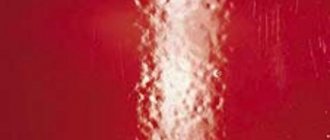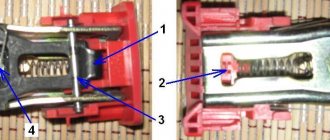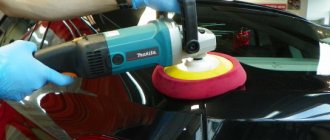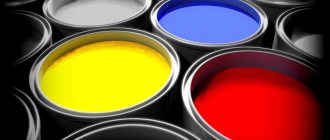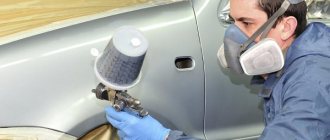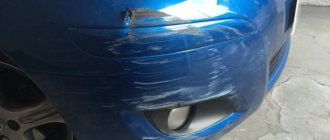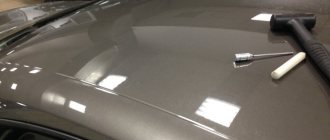Common causes of paint defects
Painting a car is not a simple undertaking that requires accuracy, attentiveness, patience and experience. To ensure that the paint applies evenly and there are no defects, you need to follow the rules and conditions of painting. Otherwise, defects arise - shagreen, graininess, smudges, etc.
Let us briefly highlight the most common causes of defects:
- Use of poor quality paint;
- Failure to comply with proportions when diluting paint;
- The spray gun is not configured;
- Failure to comply with spray gun painting technology;
- Failure to comply with drying time intervals;
- Dust on paint.
Leaks also occur as a result of dust. In order not to repaint this part again, you need to be aware of how to remove smudges after painting a car.
In most cases, defects appear due to the inexperience of the technician.
But all defects can be removed, especially when they occupy a large area. In such a situation, you will have to repaint the car yourself, or contact a car service specialist.
High-tech equipment, automation of many stages of work, high-quality auto enamels, and a Termomeccanica painting and drying chamber guarantee high-quality painting of your car.
Deterioration of paintwork due to environmental influences
During the operation of the car, its coating is greatly affected by all kinds of insects that break on the hood and other parts of the body. Such impacts leave small spots, then, under the influence of high temperatures and humidity, the dead insect seems to “sink” deep into the car’s coating.
Because of this swelling, the paint begins to deteriorate at an accelerated pace. And although the damage is only a few millimeters in size, it can have a very negative impact on the paintwork. You should try to notice such defects immediately and eliminate them.
To do this, you need to thoroughly wash the vehicle using special shampoos. After it dries, all affected areas are treated with a special liquid to remove adhering insects (you can purchase it at a specialized auto store). Then the surface is thoroughly cleaned with a degreaser and treated with solid mastic.
Some defects can be caused by seemingly harmless bird droppings. The damaged area usually appears duller than the rest of the coating and the area is slightly corroded. It is in hot weather that bird droppings most seriously damage the paint and varnish that covers the car.
If it is not eliminated in time, it can cause chemical burns to the surface, cracks, and the paint layer in this place can be etched down to the putty layer. If the damage to the body is minor, it can be removed by polishing using special pastes and polishes.
On the body you can also see drops of a brown tint from drops of sap or resin dripping from the trees. They have a destructive effect on the paint layer in the warm season; in winter, the resins practically do not destroy the coating. Due to exposure to high temperatures, the resin begins to melt, its components react actively with the enamel that covers the body and this leads to swelling.
You can get rid of swollen areas in a paint drying box. There, using infrared radiation, the ambient temperature is achieved at 60C, then warm up the vehicle for about an hour. You can remove stuck particles of resin from the body using a clean cloth soaked in kerosene (gasoline).
The secretions of aphids can erode the body coating almost down to the putty. Such droplets no larger than 1 mm in size greatly damage the paint layer, so they need to be removed as quickly as possible. Any tarnished paint that remains after this can be removed by thoroughly polishing the car.
After cement gets on the surface of a car in the warm season, it begins to form alkaline compounds that corrode the paint layer. Therefore, you need to immediately wash off the dirt and remove dull spots after them by polishing. If the cement has already dried, you can soften it by applying a napkin soaked in vinegar to it. After this, the cement is carefully removed, the area must be thoroughly rinsed with ordinary running water and polished.
Industrial dust deposits leave defects on the body that differ in color from the rest of the coating (can have all shades from red to blue). If such islands are not removed in time, rust forms in those places, which can rapidly increase in size.
defect in paintwork
Dust that contains iron particles is very difficult to remove from the surface of the body, and if this is not done immediately, after a few days it will become completely impossible. Dust can be removed from the surface during the washing process, then finishing polishing can be done using a cleaning mastic.
Some flaws form even at the time of painting and can become noticeable immediately after drying.
Preparatory work and what is needed for this
It is worth keeping in mind that smudges must be eliminated before applying the finishing coat of paintwork . Before this event, prepare everything you need for work.
What is needed to eliminate smudges
To eliminate smudges on metal and plastic, you need to have the following:
- Masking tape;
- Sandpaper;
- Water;
- Sharp blade;
- A wooden block to wrap the skin;
- Polishing paste and machine;
Description of marriage
Varnish runs are when paint from the top area has moved down. It turned out that in one place the layer is too thin, and in another there is a clear excess, which is visible and “hurts the eye.” Not everyone clearly understands what shagreen is when painting. It is sometimes called automobile cellulite. Shagreen is a very common problem when priming or painting car parts with a toothbrush or airbrush. The paint falls on the body in small lumps instead of a smooth layer. This adds unacceptable roughness and spoils the appearance too much. Typical reasons are high spray pressure, too thick paint, quickly evaporating solvent. A little experience can also affect the appearance of this defect. Smudges and shagreen are related defects. They have a lot in common, a lot can be removed in one way. The main technology of work is based on the experience and handicraft developments of craftsmen. A serious automaker is not interested in this. It is more profitable for him when a person buys a new car.
How to remove paint smudges after painting a car
How to remove smudges after painting a car, so as not to spoil all the layers of paintwork, and there is no need to paint the car again? Defects are eliminated only when the paint layer has dried.
Worth remembering! When trying to remove smudges on fresh paint, you risk removing the lower layers. As a result, it will be necessary to repaint.
Removing smudges is performed in the following order.
First stage. The boundaries of the surface area in which there are defects are indicated. This is done so as not to overdo it and not damage the paintwork without defects.
Second phase. Using a blade, paint smudges are cut off. This must be done carefully, removing the tops of the drops. If they are small, then you can immediately begin sanding.
Third stage. It includes sanding. The skin, which has a grain size of P800, must be wrapped in a bar. Perform grinding Periodically water the treated area with water. As the smudges decrease, replace the sandpaper with a finer one. Sanding ends with P2000 sandpaper.
It is worth cleaning the defect carefully; it is better not to rub it than to overdo it. Because An excess layer of paint may be removed and it will be necessary to repaint. The surface can be smoothed using longer polishing.
Fourth stage . Uniform polishing is carried out. Never hold the sander in one place.
Video on how to remove smudges after painting a car:
Eliminating smudges with a cylindrical grinder
Defects can be removed by using a wheel grinder with different abrasives. However, this method requires some skills, because Due to inexperience, you can remove all the paint on the treated area, as well as touch the primer.
How to remove minor paint smudges after painting a car
If individual parts of the body , for example, a bumper, and a smudge appears.
And the paint has not yet dried, so you can get rid of the smudges much easier. To do this, simply turn the surface to be painted so that the undried paint is distributed evenly on its own. Also, small smudges can be carefully eliminated with another coat of paint.
Ways to Avoid Grain and Matte Spots
Surface graininess occurs when tiny hard particles get into the car enamel or onto the surface to be painted. This could be dust from the premises, or “dirt” from poorly filtered paint. Even in a mixture prepared on a special stand, there may be solid formations that cannot be dissolved. Preventing the grainy effect is quite simple by ensuring that the following conditions are met:
- The box for painting a car or its body parts must be thoroughly washed and isolated from the environment (it is advisable to make a screen of plastic film in the form of a gateway on the front door)
- Before pouring enamel into the spray gun, use a coarse filter. It will not allow small hard particles to pass through, which will be very noticeable on the coating. Each applied layer of paint will visually increase their size.
This defect is difficult to eliminate; you will have to remove the coating down to the metal and repaint it again. It is better to wash the floor once again and lock the hangar doors until the repair work is completed.
Sometimes matte spots appear on a sparkling and smoothly painted surface. This occurs because the etchant was not completely removed or the putty areas were poorly primed. Particles of car enamel are intensively absorbed by the porous surface, and the paintwork loses its shine. High-quality priming before applying the material is guaranteed to get rid of dull spots.
How to paint a car with acrylic?
Following the rules for painting a car body with acrylic will allow you to avoid defects on the surface.
Painting is carried out in 3 stages:
- Applying the base layer.
- Base layer.
- Applying a protective layer.
Video about painting a car with acrylic:
Painting a car with acrylic requires strict adherence to proportions. Because if you add too much thinner, the paint will become too thin. As a result, smudges will form. It is also worth considering that the temperature inside the room must be observed, it must be over 20 degrees.
Worth remembering! If the temperature is not maintained, the paint will take much longer to dry, and smudges will form.
Where do the drips come from?
The main reasons that the paint goes on unevenly is non-compliance with the painting rules. And this manifests itself in different ways.
- Failure to follow the instructions for the paint: the proportions of the pigment and solvent are incorrect, or the thinner used does not match the paint. As a result, the composition turned out to be too liquid, and it is not able to stay on the body;
- The spray gun is not adjusted before use;
- The muzzle of the apparatus was held at an angle, or at too great a distance from the surface, or over one area for too long;
- During the work, dust got into the paint;
- The temperature regime was violated when storing the compositions or in the room where painting was carried out;
- The required time interval was not maintained between individual layers, and the previous one did not dry completely before applying the next one;
- Well, and, of course, low-grade paint. Moreover, it does not have to be cheap: you can buy an expensive one, but an unsuccessful one, or a trusted manufacturer, but a fake.
Minor flaws:
Some defects can be corrected either immediately or without additional effort. So, if you are painting a separate element of the body and notice that the paint has flowed, you need to quickly turn it: the composition that has not yet dried will be evenly distributed over the surface.
If drips are detected after drying, but are very small (for example, they are not visually detected, but can be felt), another applied layer of paint can help out. Just this time, try to do everything as correctly as possible.
